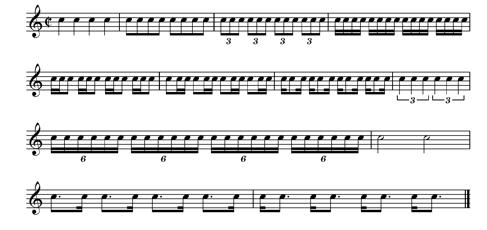Improving Your Rhythm and Time on Guitar
By Pete Sklaroff
This lesson is all about improving your rhythm and time on guitar. Although aimed at guitarists primarily, it will hopefully contain material that could be easily employed by other instrumentalists as well. My goal in producing this lesson was to offer up some simple rhythmic concepts that have helped me enormously in my own understanding of rhythm and that I have passed on to many guitar students in my teaching work over the years.
Playing with good time and a strong awareness of rhythm is absolutely essential for any musician in my view, and far too many players focus their entire attention (in practice) on what to play harmonically and melodically, rather than how to play it all rhythmically. This was the case in my own playing for many years too, as I was trying to digest as much melodic and harmonic material as I could, perhaps in the vain hope that this alone would make me a better musician. I now realise that improving your rhythm and time on guitar is the quickest way to succeed.
Neglecting rhythm however is a dangerous path for any player to take, as no matter how fluent you feel you sound with a whole variety of scales, chord forms and arpeggios etc. you will never sound comfortable (and musically accessible) to a listener unless you play with good time and phrase well rhythmically.
Many musicians talk about other players who have a ‘great time-feel’ or have a good ‘groove’ to their playing and by this they mean that the player has a good conception of rhythm and their music is organised well in rhythmic terms. In fact their music ‘feels’ good somehow because of this, as opposed to players who have a good overall instrumental technique but somehow lack rhythmic authority or precision.
As a first step – being able to play common rhythms accurately and consistently is a vital skill for any musician and it’s especially the case with anyone who improvises, as they have to keep audience interest in their improvisation and also engage their fellow musicians. Rhythm is vital for this process.
To begin our lesson in practical terms, you might initially ask yourself just how comfortable you are with basic rhythms in the most common time signature of 4/4. This is something that many musicians assume they are already very familiar with, but then subsequently find that they are in fact ‘rushing’ or ‘dragging’ against the pulse of the music. It’s particularly common for guitarists for example to play ‘ahead of the beat’ (in effect rushing the tempo) perhaps in some way due to the fact that we play a percussive and not a wind driven or breath controlled instrument and it’s therefore easy to play in front of the beat and for prolonged periods of time.
The musical table shown below outlines 12 basic rhythms which can be used to sub-divide a bar of 4/4. The rhythms range from minims (half notes) up to semi-qaver triplets (16th note triplets or 6 notes per beat) These rhythms are crucial to understand (and play correctly) if you are going to become more rhythmically aware (and secure) in your playing.
To test yourself on your current understanding and facility with these rhythms, take a metronome and set it to a comfortable (but fairly slow tempo) and try playing just a single note, whilst going through each of the rhythms notated on the sheet. (You might also try repeating each rhythmic division several times before moving onto the next to ensure complete accuracy etc.)
Table of Rhythms

If the volume of your guitar is roughly equal to that of the ‘click’ on the metronome, then you may well experience the ‘click’ disappearing (in terms of sound) when you play the notes, if you are accurately matching the beats. If you find that you are producing sounds that don’t seem to match up with the metronome (or if the whole process just seems very uncomfortable to you) then you may need to put in some extra practice time to remedy this.
* Edit, a few people have been asking on reddit about playing triplets accurately. Here is the notation to show how different triplets lie against a 1/4 note pulse:

Once you can comfortably play through all 12 rhythms without any errors, then try some additional exercises to reinforce your rhythmic awareness. This could include (but is not limited to) the following:
– Play each rhythm with a single chord voicing (and then with varied chord voicings)
– Play each rhythm using a single scale (in different locations on the fretboard)
– Play each rhythm using a single arpeggio (in different locations on the fretboard)
– Try improvising over a familiar progression using some of the rhythms (exclusively) in your solo.
These exercises may well make a quite radical difference to your playing, as they will serve to highlight not only how confident you are with a variety of common rhythms, but also whether you only employ a few rhythmic subdivisions in your existing playing and need to expand upon this. Many students that I have given this exercise to notice a radical improvement in their playing quite quickly, due to suddenly becoming far more aware of how they use rhythm.
Briefly returning to the subject of metronomes, you can be rather creative with them too. Instead of just having the ‘click’ produced by the metronome sounding on every crotchet (or quarter note) beat you can also experiment with having it sound on different beats in the bar. A lot of jazz players for example, use the metronome this way by having it sound on beats 2 & 4 (in 4/4 time) to help develop a ‘swing feel’ in their playing and this would also help you considerably if you play Blues or R&B style music as the ‘click’ imitates the ‘backbeat’ of such music.
Metronomes don’t replace working with a great drummer of course or indeed provide you with a wonderful groove to play against, but they do alert you to common rhtyhmic issues like rushing or dragging against the pluse of the music, so I do recommend using one at least part of the time in your rhythmic parctice, especially if you feel that your time needs improvement.
In summary, although I have met some musicians over the years who have a very secure and seemingly natural sense of time, most of us mere mortals don’t have this and really need to work on our rhythmic awareness and application.
Practicing rhythms can be great fun too, and may well just bring you a welcome boost to your playing.
Happy Practicing!
Pete Sklaroff

Pete Sklaroff is the former Assistant Head of Music and Head of Jazz Studies at Leeds College of Music in West Yorkshire (where he taught for over 20 years) and he now works freelance as a professional guitarist, session musician, clinician and music educator/guitar tutor in the UK. His career spans over 25+ years as a professional musician and he has toured and recorded extensively in that time.
“The artists you work with, and the quality of your work speaks for itself.”
Tommy Emmanuel
© Copyright Fundamental Changes Ltd 2025
No.6 The Pound, Ampney Crucis, England, GL7 5SA
